Utilizing a CRM (buyer relationship administration) platform is just about customary apply—91% of companies with greater than 10 staff use one.
However what’s much less widespread is constructing a complete CRM implementation course of.
Generally, enterprise leaders join an account with their most well-liked CRM platform after which throw entry to their division leaders (gross sales, advertising and marketing, success) and allow them to determine it out.
The consequence?
Disconnected relationship administration processes, poor knowledge governance, and altogether inefficient use of the system.
On this article, we’ll define the 8 vital steps to designing a profitable CRM rollout, so you possibly can keep away from these errors and get working effectively from the get-go.
However first, let’s make clear some issues about buyer relationship administration.
Desk of Contents
CRM implementation: the fundamentals
The time period “CRM,” for higher or worse, has a few totally different meanings.
The acronym stands for Buyer Relationship Administration. So, technically, CRM is the enterprise course of that focuses on enhancing relationships with potential and present clients to retain and drive new income.
Therefore, CRM as a enterprise course of is used for gross sales, advertising and marketing, assist, and buyer success.
However right here’s the place issues get difficult.
CRM has grow to be such a ubiquitous and essential enterprise endeavor that a complete sector of software program platforms has emerged, referred to as CRM platforms, however now extensively known as “CRMs” or “the CRM,” that are used to handle current relationships and nurture gross sales alternatives.
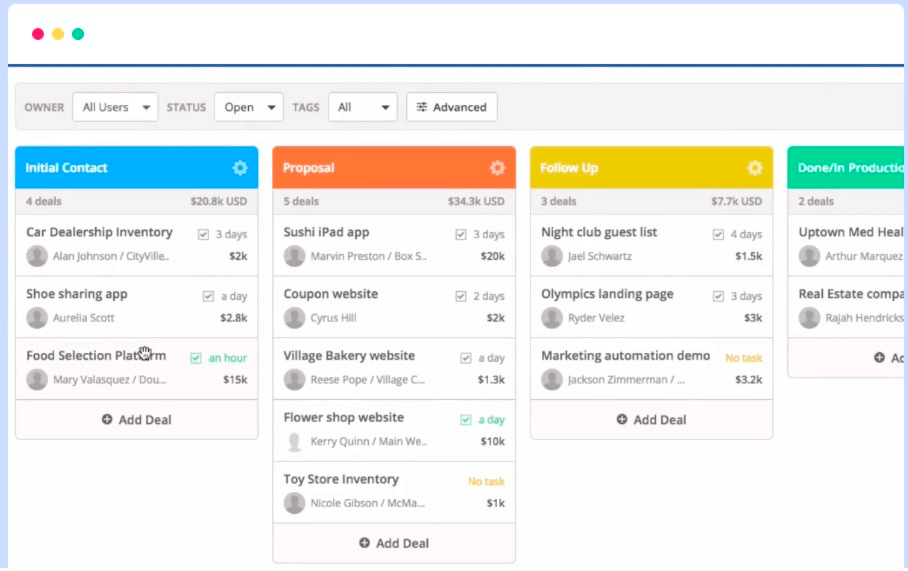
Right here’s the important thing:
If somebody says “a CRM,” “the CRM,” “our CRM,” or some other phrase that refers to CRM as a “factor,” then they’re speaking a couple of CRM software program platform.
In the event that they seek advice from CRM within the context of “CRM processes” or “CRM leaders,” they’re referring to the overarching thought of managing buyer relationships.
What’s the function of CRM?
The aim of CRM (the method and the resultant software program tech) is to enhance the standard of buyer relationships.
Companies obtain this by way of a number of initiatives, comparable to:
- Improved entry to buyer knowledge (to allow them to higher serve people on a customized stage but in addition apply this data to new consumer acquisition)
- Higher communications cadences (by way of scheduling, reminders, and automation)
- Model consistency (communications will be templated and automatic)
The overarching thought behind buyer relationship administration is straightforward:
Should you can enhance the connection between your model and your clients, you’ll preserve clients for longer. They’ll spend extra, be extra prone to refer mates, household, and colleagues, and allow you to develop income.
Is CRM a instrument or course of?
Properly, each.
Buyer relationship administration is a broad enterprise apply that focuses on creating the brand-customer relationship.
It isn’t, in itself, a course of, although particular person organizations will develop inner processes inside a wider CRM apply.
However CRMs are additionally instruments if we’re referring to CRM software program platforms. Nonetheless, these software program instruments don’t substitute buyer relationship administration processes; they assist them.
What’s the CRM lifecycle?
The CRM lifecycle is an idea that refers back to the phases a given buyer strikes by way of and the way your organization approaches managing the customer-brand relationship based mostly on the stage they’re at.
There are 5 key phases within the typical CRM life cycle mannequin, aligning intently with the everyday gross sales cycle:
- Attain
- Acquisition
- Conversion
- Retention
- Loyalty
Advertising is answerable for the attain stage (operating adverts and distributing content material to achieve potential shoppers). They work intently with gross sales groups throughout acquisition (turning potential clients into leads).
From there, gross sales nurtures the connection by way of to the conversion stage (the place the lead turns into a buyer) after which palms the shopper over to the service and success groups to proceed rising that relationship.
Their aim is to maintain the shopper on board (by way of buyer retention and buyer satisfaction initiatives) and delight them a lot that they refer mates, household, or colleagues (which we take into account the loyalty stage of the life cycle).
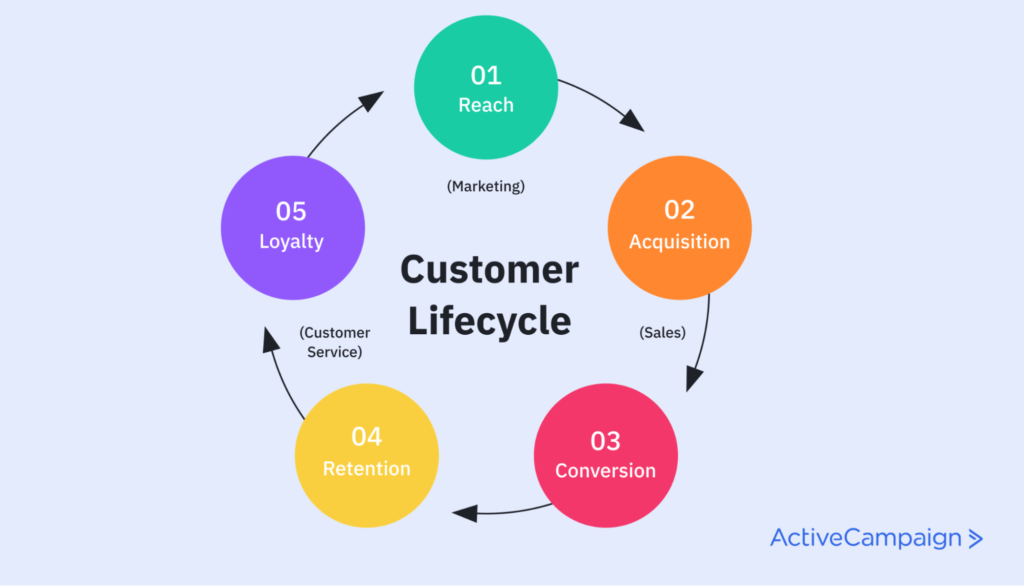
We visualize the CRM lifecycle as an infinite loop, as loyal clients are those who grow to be advocates for our model. They refer different clients and grow to be a part of the “attain” phases for these new clients.
The best way to implement CRM in 8 steps
With these CRM fundamentals out of the way in which, how can your group put collectively a profitable CRM implementation technique to make sure the success of your new endeavor?
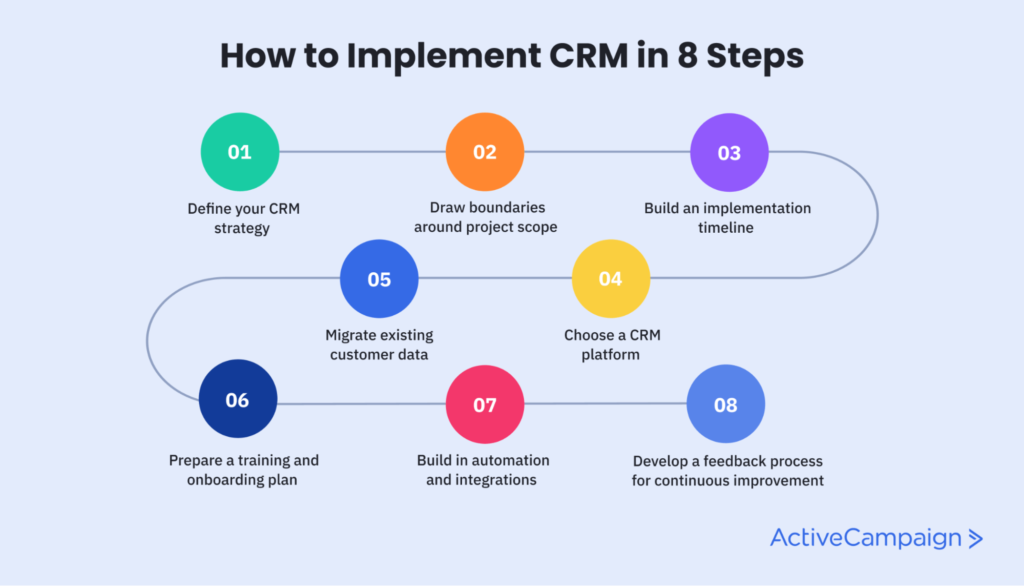
1. Outline your CRM technique
Like several good enterprise endeavor, step one in CRM implementation is knowing (and speaking) your core enterprise objectives.
Ask:
- What downside(s) are we attempting to resolve by implementing the CRM course of?
- How are we managing these issues now?
- What are the implications if we don’t resolve them? And if we do?
- What precisely wants to vary in our group?
- What outcomes are we anticipating to see post-implementation?
- What’s our timeline for seeing these outcomes, and the way will we measure that success?
2. Draw boundaries across the venture scope
New enterprise tasks are likely to develop in scope sneakily.
Undertaking managers name this phenomenon “scope creep,” the place, over time, new initiatives are slowly added into the preliminary implementation methodology, to some extent the place the venture is overwhelmingly giant and takes far longer to finish than deliberate.
The most effective apply for avoiding scope creep is to outline the boundaries of your endeavor from the get-go clearly.
Element:
- Who’s the venture supervisor?
- What different stakeholders exist as a part of the implementation staff? What’s their function within the venture?
- What are the objectives of the venture (referring to what you lined in the first step)?
- What precisely are the initiatives that will probably be accomplished on this venture?
- What potential initiatives should be famous as “out of scope?”
Then, outline a course of for coping with new concepts which may be out of scope (as a result of they will pop up).
How will you identify whether or not it’s essential to incorporate these within the current scope or outline them as “outdoors of scope” or “future venture?”
3. Construct an implementation timeline
With the scope outlined, the next move is constructing an implementation timeline. Selecting a single deadline date for venture completion will probably be inadequate right here.
As an alternative, break down your CRM implementation course of into digestible chunks that make sense from sensible and sequential views.
For instance, your CRM implementation plan may embody phases comparable to:
- Performing an inner evaluation of enterprise course of
- Assessing numerous CRM software program choices
- Understanding required software program integrations
- Consulting with enterprise unit leaders (e.g., the gross sales supervisor or buyer assist reps)
- Getting ready a price evaluation and approving finances
- CRM migration
- Consumer coaching and improvement with core staff members
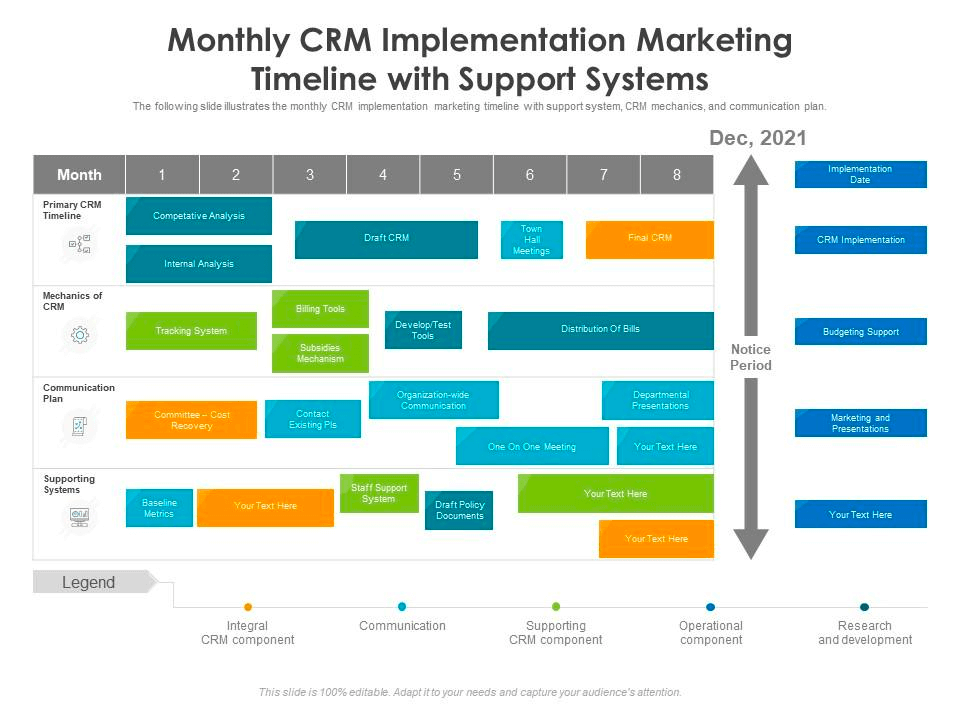
When you’ve constructed out the important thing phases within the CRM implementation course of, set acceptable due dates, outline dependencies (the place 1 stage depends on the completion of a earlier, for instance, the finances must be ready earlier than it may be authorized), and map the timeline out visually.
4. Select a CRM platform
Now it’s software program time.
There are a bunch of nice CRM software program platforms on the market. Lots of them share the identical fundamental options, however every caters to barely totally different audiences, wants and necessities, and enterprise phases.
Throughout the board, nonetheless, important options to prioritize embody:
- Automation capabilities
- Integrations with different software program packages
- Information safety
- High quality of buyer assist
- Availability of self-help sources
- Scalability and ease of use
5. Migrate current buyer knowledge
When you’ve selected an acceptable CRM answer, you’ll need to set it up and get all your current buyer data in there.
That knowledge may come from a earlier CRM platform, lead administration instrument, a spreadsheet (or sequence thereof), or a earlier buyer data administration platform.
Ideally, you’ll work together with your CRM supplier emigrate this data, although that can rely upon their providing and skill emigrate knowledge out of your present platform.
Be sure that to construct this course of into your timeline (and provides your self a little bit further buffer time, as knowledge migration could be a headache, particularly when you’re managing it internally).
6. Put together a coaching and onboarding plan
Gaining staff buy-in on the brand new CRM venture can show difficult, however will probably be particularly tough if staff are unclear on use the factor.
In a super world, your CRM software program supplier can present onboarding and coaching. Nonetheless, this isn’t supplied by all suppliers and could also be unrealistic for giant firms with a whole bunch of staff.
On this case, constructing a complete inner onboarding and coaching plan is vital.
Rolling out CRM utilization in phases could be a precious technique. You are able to do this by territory (e.g., beginning with North American groups earlier than rolling out to EMEA and onward) or by staff (e.g., beginning with gross sales, then incorporating success, then advertising and marketing).
In any case, clearly outline a problem-solving course of, and construct a office wiki or doc storage answer for CRM-based sources (for instance, a information and video on “The best way to add a brand new account in our CRM”).
7. Construct in automations and integrations
Two of essentially the most highly effective options supplied by right this moment’s CRM platforms are the flexibility to automate guide work (as an example, touchpoints within the gross sales course of) and to combine with the opposite instruments you’re already utilizing (like e-mail advertising and marketing instruments you utilize to nurture prospects all through the shopper journey).
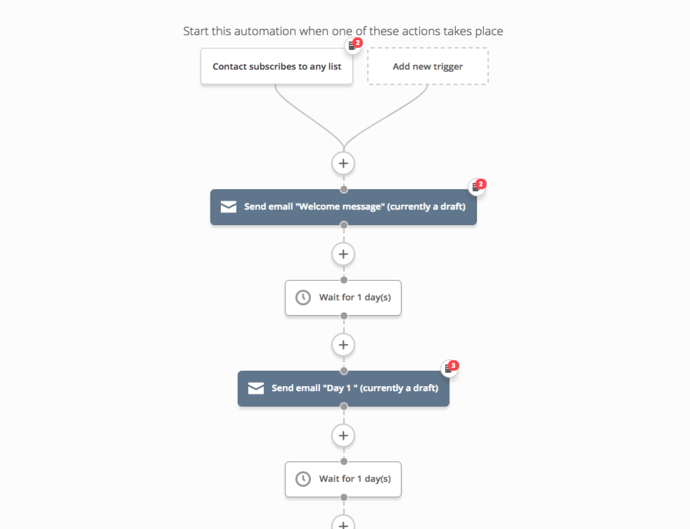
Work together with your assist and gross sales reps to grasp the duties they full recurrently and seek the advice of together with your CRM supplier to find out what will be automated.
For instance, in case your gross sales staff operates a 7-step telephone name and e-mail cadence, you possibly can set that cadence up in your CRM with automated name reminders and e-mail sends.
8. Develop a suggestions course of for steady enchancment
Lastly, it’s essential to arrange a system for capturing suggestions from every staff member post-rollout.
A straightforward approach could be to arrange an nameless type (maybe in your shiny new CRM platform) the place staff can share their ideas on the implementation course of and the way the brand new CRM impacts their work life.
Conclusion
Following these 8 steps will allow you to guarantee a profitable implementation venture.
If you wish to work a bit sooner, you possibly can skip step 4 (selecting a CRM platform) and leap straight into ActiveCampaign. Attempt us out right this moment with a free 14-day trial.
{
“@context”: “https://schema.org”,
“@kind”: “FAQPage”,
“mainEntity”: [{
“@type”: “Question”,
“name”: “What is the purpose of CRM?”,
“acceptedAnswer”: {
“@type”: “Answer”,
“text”: “The purpose of CRM (the process and the resultant software tech) is to improve the quality of customer relationships.
Businesses achieve this through several initiatives, such as:
Improved access to customer data (so they can better serve individuals on a personalized level but also apply this information to new client acquisition)
Better communications cadences (through scheduling, reminders, and automation)
Brand consistency (communications can be templated and automated)
The overarching idea behind customer relationship management is simple:
If you can improve the relationship between your brand and your customers, you’ll keep customers for longer. They’ll spend more, be more likely to refer friends, family, and colleagues, and altogether help you grow revenue.”
}
},{
“@type”: “Question”,
“name”: “Is CRM a tool or process?”,
“acceptedAnswer”: {
“@type”: “Answer”,
“text”: “Well, both.
Customer relationship management is a broad business practice that focuses on developing the brand-customer relationship.
It is not, in itself, a process, though individual organizations will develop internal processes within a wider CRM practice.
But CRMs are also tools if we’re referring to CRM software platforms. However, these software tools don’t replace customer relationship management processes; they support them.”
}
},{
“@type”: “Question”,
“name”: “What is the CRM life cycle?”,
“acceptedAnswer”: {
“@type”: “Answer”,
“text”: “The CRM life cycle is a concept that refers to the stages a given customer moves through and how your company approaches managing the customer-brand relationship based on the stage they’re at.
There are 5 key stages in the typical CRM life cycle model, aligning closely with the typical sales cycle: reach, acquisition, conversion, retention, and loyalty.
Their goal is to keep the customer on board (through customer retention and customer satisfaction initiatives) and delight them so much that they refer friends, family, or colleagues (which we consider the loyalty stage of the life cycle).”
}
}]
}

